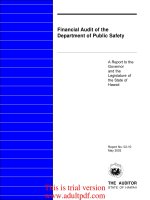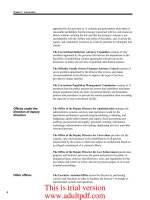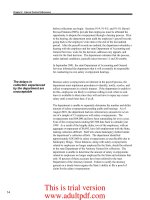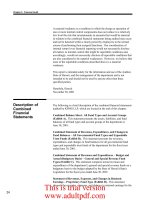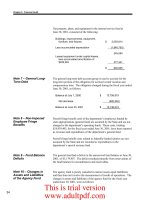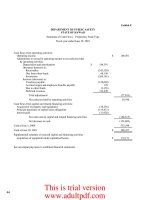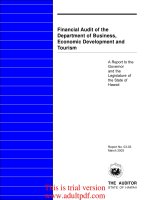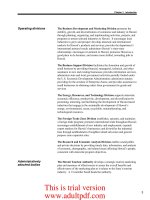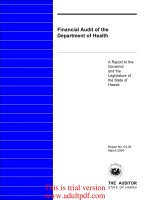Financial Audit of the Department of Human Resources Development A Report to the Governor and the Legislature of the State of Hawai‘i Report No. 07-09 December 2007_part1 ppt
Bạn đang xem bản rút gọn của tài liệu. Xem và tải ngay bản đầy đủ của tài liệu tại đây (114.23 KB, 10 trang )
Financial Audit of the
Department of Human
Resources Development
A Report to the
Governor
and the
Legislature of
the State of
Hawai‘i
THE AUDITOR
STATE OF HAWAI‘I
Report No. 07-09
December 2007
This is trial version
www.adultpdf.com
Office of the Auditor
The missions of the Office of the Auditor are assigned by the Hawai‘i State Constitution
(Article VII, Section 10). The primary mission is to conduct post audits of the transactions,
accounts, programs, and performance of public agencies. A supplemental mission is to
conduct such other investigations and prepare such additional reports as may be directed
by the Legislature.
Under its assigned missions, the office conducts the following types of examinations:
1. Financial audits attest to the fairness of the financial statements of agencies. They
examine the adequacy of the financial records and accounting and internal controls,
and they determine the legality and propriety of expenditures.
2. Management audits, which are also referred to as performance audits, examine the
effectiveness of programs or the efficiency of agencies or both. These audits are also
called program audits, when they focus on whether programs are attaining the
objectives and results expected of them, and operations audits, when they examine
how well agencies are organized and managed and how efficiently they acquire and
utilize resources.
3. Sunset evaluations evaluate new professional and occupational licensing programs to
determine whether the programs should be terminated, continued, or modified. These
evaluations are conducted in accordance with criteria established by statute.
4. Sunrise analyses are similar to sunset evaluations, but they apply to proposed rather
than existing regulatory programs. Before a new professional and occupational
licensing program can be enacted, the statutes require that the measure be analyzed
by the Office of the Auditor as to its probable effects.
5. Health insurance analyses examine bills that propose to mandate certain health
insurance benefits. Such bills cannot be enacted unless they are referred to the Office
of the Auditor for an assessment of the social and financial impact of the proposed
measure.
6. Analyses of proposed special funds and existing trust and revolving funds determine if
proposals to establish these funds are existing funds meet legislative criteria.
7. Procurement compliance audits and other procurement-related monitoring assist the
Legislature in overseeing government procurement practices.
8. Fiscal accountability reports analyze expenditures by the state Department of
Education in various areas.
9. Special studies respond to requests from both houses of the Legislature. The studies
usually address specific problems for which the Legislature is seeking solutions.
Hawai‘i’s laws provide the Auditor with broad powers to examine all books, records, files,
papers, and documents and all financial affairs of every agency. The Auditor also has the
authority to summon persons to produce records and to question persons under oath.
However, the Office of the Auditor exercises no control function, and its authority is limited
to reviewing, evaluating, and reporting on its findings and recommendations to the
Legislature and the Governor.
THE AUDITOR
STATE OF HAWAI‘I
Kekuanao‘a Building
465 S. King Street, Room 500
Honolulu, Hawai‘i 96813
This is trial version
www.adultpdf.com
The Auditor State of Hawai‘i
OVERVIEW
Financial Audit of the Department of Human Resources
Development
Report No. 07-09, December 2007
Summary
The Office of the Auditor and the certified public accounting firm of Accuity LLP
conducted a financial audit of the Department of Human Resources Development,
State of Hawai‘i, for the fiscal year July 1, 2005 to June 30, 2006. The audit
examined the financial records and transactions of the department; reviewed the
related systems of accounting and internal controls; and tested transactions,
systems, and procedures for compliance with laws and regulations.
In the opinion of the firm, the financial statements present fairly, in all material
respects, the department’s financial position of its general fund and human
resources development special fund as of June 30, 2006, and the respective
changes in financial position and the respective budgetary comparison for the
general and major special revenue funds for the year then ended in conformity with
accounting principles generally accepted in the United States of America. However,
the firm was not able to apply auditing procedures to satisfy themselves regarding
the amounts reported as workers’ compensation liability and the related workers’
compensation expense in the statement of net assets and statement of activities.
Additionally, the firm disclaimed opining on the workers’ compensation and
unemployment insurance interdepartmental accounts in the governmental funds.
With respect to the department’s internal control over financial reporting and
operations, we found two material weaknesses. First, we found that accounting
personnel and accurate financial reporting are not a priority of the department.
While the department is proficient with day-to-day tasks, it lacks a formal internal
financial reporting process. The department also does not produce financial
statements and is not subject to annual financial audits. Collectively, these factors
contributed to certain account balances being misstated as of June 30, 2006.
Further, external stakeholders, including the public, are left with no means to
evaluate the financial performance of the department.
The second material weakness is that the department has not taken functional
ownership of the Workers’ Compensation Program. The department is responsible
for planning and administering the Workers’ Compensation Program for a
majority of state agencies and the Legislature; however, it does not systematically
calculate, track, and report the approximately $29 million in related liabilities.
Additionally, the department has not established formal policies over processing
related claims to avoid potential exposure to related litigation. As a result, we
found that workers’ compensation expenditure and liability balances were
significantly misstated as of June 30, 2006.
This is trial version
www.adultpdf.com
Report No. 07-09 December 2007
Marion M. Higa Office of the Auditor
State Auditor 465 South King Street, Room 500
State of Hawai‘i Honolulu, Hawai‘i 96813
(808) 587-0800
FAX (808) 587-0830
We recommend that the department train current accounting staff and enable them
to, or hire personnel with the experience necessary to, perform advanced financial
accounting functions that include preparing financial statements, designing systems
of internal controls and financial reporting, providing training to other staff, and
reviewing financial reports to identify discrepancies.
We also recommend that the department establish formal, written policies and
procedures governing workers’ compensation claims that include, among other
things, guidelines for initial estimates, updates, and reviews of reserves.
The department expressed its appreciation of the value of audits but disagreed with
many of our findings and conclusions. The department provided detailed
explanations supporting its disagreement with our findings. However, the
department’s responses either do not specifically address, or demonstrate a lack of
understanding of, the actual findings. We stand by our conclusions presented in
the final report and believe our audit report presents a balanced and accurate
analysis of the department’s financial operations.
Recommendations
and Response
This is trial version
www.adultpdf.com
Financial Audit of the
Department of Human
Resources Development
Report No. 07-09
December 2007
A Report to the
Governor
and the
Legislature of
the State of
Hawai‘i
Conducted by
The Auditor
State of Hawai‘i
and
Accuity LLP
THE AUDITOR
STATE OF HAWAI‘I
Submitted by
This is trial version
www.adultpdf.com
Foreword
This is a report of the financial audit of the Department of Human
Resources Development, State of Hawai‘i, for the fiscal year July 1,
2005 to June 30, 2006. The audit was conducted pursuant to
Section 23-4, Hawai‘i Revised Statutes, which requires the State Auditor
to conduct postaudits of all departments, offices, and agencies of the
State and its political subdivisions. The audit was conducted by the
Office of the Auditor and the certified public accounting firm of Accuity
LLP.
We wish to express our appreciation for the cooperation and assistance
extended by the officials and staff of the Department of Human
Resources Development.
Marion M. Higa
State Auditor
This is trial version
www.adultpdf.com
v
Table of Contents
Chapter 1 Introduction
Background 1
Organization 1
Prior Financial Audit 4
Objectives of the Audit 5
Scope and Methodology 5
Chapter 2 Internal Control Deficiencies
Summary of Findings 7
Accounting Personnel and Accurate Financial
Reporting Are Not a Priority 7
Recommendations 12
No Functional Ownership of the Workers’
Compensation Program Exists 12
Recommendations 22
Chapter 3 Financial Audit
Summary of Findings 23
Independent Auditors’ Report 23
Report of Independent Auditors on Internal
Control Over Financial Reporting and on
Compliance and Other Matters Based on an
Audit of Financial Statements Performed in
Accordance With Government Auditing
Standards 26
Description of Basic Financial Statements 28
Notes to Basic Financial Statements 30
Response of the Affected Agency 63
List of Exhibits
Exhibit 1.1 State of Hawai‘i, Department of Human Resources
Development, Organizational Chart 2
Exhibit 2.1 Expired Contracts 11
This is trial version
www.adultpdf.com
vi
Exhibit 2.2 Workers’ Compensation Expense and Reserve as
of, and for the Year Ending June 30, 2006 15
Exhibit 2.3 Workers’ Compensation Claims - Incurred But Not
Reported Reserves 17
Exhibit 2.4 Overstatement of Reserve Type 20
Exhibit 2.5 Claims Misstatements 21
Exhibit 3.1 State of Hawai‘i, Department of Human Resources
Development, Management’s Discussion and
Analysis, June 30, 2006 43
Exhibit 3.2 Department of Human Resources Development,
State of Hawai‘i, Statement of Net Assets,
June 30, 2006 54
Exhibit 3.3 Department of Human Resources Development,
State of Hawai‘i, Statement of Activities, Year
Ended June 30, 2006 55
Exhibit 3.4 Department of Human Resources Development,
State of Hawai‘i, Balance Sheet - Governmental
Funds, June 30, 2006 56
Exhibit 3.5 Department of Human Resources Development,
State of Hawai‘i, Statement of Revenues,
Expenditures and Changes in Fund Balances -
Governmental Funds, Year Ended June 30, 2006 57
Exhibit 3.6 Department of Human Resources Development,
State of Hawai‘i, Reconciliation of the
Governmental Funds Balance Sheet to the
Statement of Net Assets, June 30, 2006 58
Exhibit 3.7 Reconciliation of the Governmental Funds
Statement of Revenues, Expenditures and
Changes in Fund Balances to the Statement of
Activities, Year Ended June 30, 2006 59
Exhibit 3.8 Statement of Revenues and Expenditures - Budget
and Actual (Budgetary Basis) General Fund,
Year Ended June 30, 2006 60
Exhibit 3.9 Statement of Revenues and Expenditures - Budget
and Actual - Other Major Funds, Year Ended
June 30, 2006 61
This is trial version
www.adultpdf.com
1
Chapter 1: Introduction
Chapter 1
Introduction
This is a report of our financial audit of the Department of Human
Resources Development, State of Hawai‘i. The audit was conducted by
the Office of the Auditor and the independent certified public accounting
firm of Accuity LLP. The audit was conducted pursuant to Section 23-4,
Hawai‘i Revised Statutes (HRS), which requires the State Auditor to
conduct postaudits of the transactions, accounts, programs, and
performance of all departments, offices, and agencies of the State of
Hawai‘i and its political subdivisions.
The Department of Human Resources Development is part of the
executive branch of the State of Hawai‘i. The department administers
the state personnel program, provides administrative support services to
statutorily and executively assigned commissions or boards, and
represents the State on other commissions and committees.
The Territorial Legislature established the Territorial Civil Service
Commission in 1939 and the Department of Civil Service in 1951. In
1959, the Department of Civil Service was renamed the Department of
Personnel Services (DPS) as part of the statehood reorganization. The
Legislature established positions and funds for a new centralized
workers’ compensation unit within DPS, which began operations in
1985. In 1992, the Legislature changed the Department of Personnel
Services to the Department of Human Resources Development to support
concepts of human resources as more than personnel processing work as
well as the employment-long development of people into productive and
motivated workers for the public service.
The department is headed by the director of human resources
development. The Office of the Director plans, organizes, directs, and
coordinates the various activities of the state personnel program in
personnel development and training, recruitment, examination, position
classification, pay administration, workers’ compensation payments, and
labor relations within the scope of laws, rules, and established policies.
Exhibit 1.1 displays the department’s organizational structure.
Background
Organization
This is trial version
www.adultpdf.com
2
Chapter 1: Introduction
Exhibit 1.1
State of Hawai‘i
Department of Human Resources Development
Organizational Chart
Source: Department of Human Resources Development
OFFICE OF THE
DIRECTOR
* BOARD OF TRUSTEES
DEFERRED COMPENSATION PLAN
(7 TRUSTEES)
INFORMATION SYSTEMS OFFICE
* MERIT APPEALS BOARD
(3 MEMBERS)
ADMINISTRATIVE SERVICES OFFICE
EMPLOYEE
RELATIONS
DIVISION
EMPLOYEE
CLASSIFICATION &
COMPENSATION
DIVISION
EMPLOYEE CLAIMS
DIVISION
EMPLOYEE
STAFFING DIVISION
This is trial version
www.adultpdf.com
